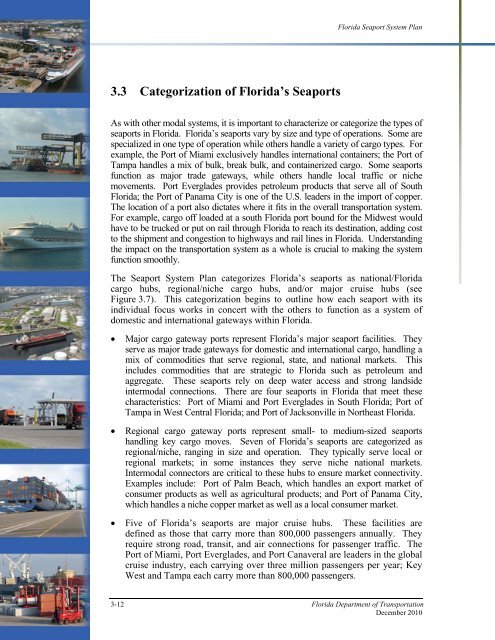Florida Seaport System Plan - SeaCIP
Florida Seaport System Plan - SeaCIP
Florida Seaport System Plan - SeaCIP
Create successful ePaper yourself
Turn your PDF publications into a flip-book with our unique Google optimized e-Paper software.
<strong>Florida</strong> <strong>Seaport</strong> <strong>System</strong> <strong>Plan</strong><br />
3.3 Categorization of <strong>Florida</strong>’s <strong>Seaport</strong>s<br />
As with other modal systems, it is important to characterize or categorize the types of<br />
seaports in <strong>Florida</strong>. <strong>Florida</strong>’s seaports vary by size and type of operations. Some are<br />
specialized in one type of operation while others handle a variety of cargo types. For<br />
example, the Port of Miami exclusively handles international containers; the Port of<br />
Tampa handles a mix of bulk, break bulk, and containerized cargo. Some seaports<br />
function as major trade gateways, while others handle local traffic or niche<br />
movements. Port Everglades provides petroleum products that serve all of South<br />
<strong>Florida</strong>; the Port of Panama City is one of the U.S. leaders in the import of copper.<br />
The location of a port also dictates where it fits in the overall transportation system.<br />
For example, cargo off loaded at a south <strong>Florida</strong> port bound for the Midwest would<br />
have to be trucked or put on rail through <strong>Florida</strong> to reach its destination, adding cost<br />
to the shipment and congestion to highways and rail lines in <strong>Florida</strong>. Understanding<br />
the impact on the transportation system as a whole is crucial to making the system<br />
function smoothly.<br />
The <strong>Seaport</strong> <strong>System</strong> <strong>Plan</strong> categorizes <strong>Florida</strong>’s seaports as national/<strong>Florida</strong><br />
cargo hubs, regional/niche cargo hubs, and/or major cruise hubs (see<br />
Figure 3.7). This categorization begins to outline how each seaport with its<br />
individual focus works in concert with the others to function as a system of<br />
domestic and international gateways within <strong>Florida</strong>.<br />
• Major cargo gateway ports represent <strong>Florida</strong>’s major seaport facilities. They<br />
serve as major trade gateways for domestic and international cargo, handling a<br />
mix of commodities that serve regional, state, and national markets. This<br />
includes commodities that are strategic to <strong>Florida</strong> such as petroleum and<br />
aggregate. These seaports rely on deep water access and strong landside<br />
intermodal connections. There are four seaports in <strong>Florida</strong> that meet these<br />
characteristics: Port of Miami and Port Everglades in South <strong>Florida</strong>; Port of<br />
Tampa in West Central <strong>Florida</strong>; and Port of Jacksonville in Northeast <strong>Florida</strong>.<br />
• Regional cargo gateway ports represent small- to medium-sized seaports<br />
handling key cargo moves. Seven of <strong>Florida</strong>’s seaports are categorized as<br />
regional/niche, ranging in size and operation. They typically serve local or<br />
regional markets; in some instances they serve niche national markets.<br />
Intermodal connectors are critical to these hubs to ensure market connectivity.<br />
Examples include: Port of Palm Beach, which handles an export market of<br />
consumer products as well as agricultural products; and Port of Panama City,<br />
which handles a niche copper market as well as a local consumer market.<br />
• Five of <strong>Florida</strong>’s seaports are major cruise hubs. These facilities are<br />
defined as those that carry more than 800,000 passengers annually. They<br />
require strong road, transit, and air connections for passenger traffic. The<br />
Port of Miami, Port Everglades, and Port Canaveral are leaders in the global<br />
cruise industry, each carrying over three million passengers per year; Key<br />
West and Tampa each carry more than 800,000 passengers.<br />
3-12 <strong>Florida</strong> Department of Transportation<br />
December 2010
















